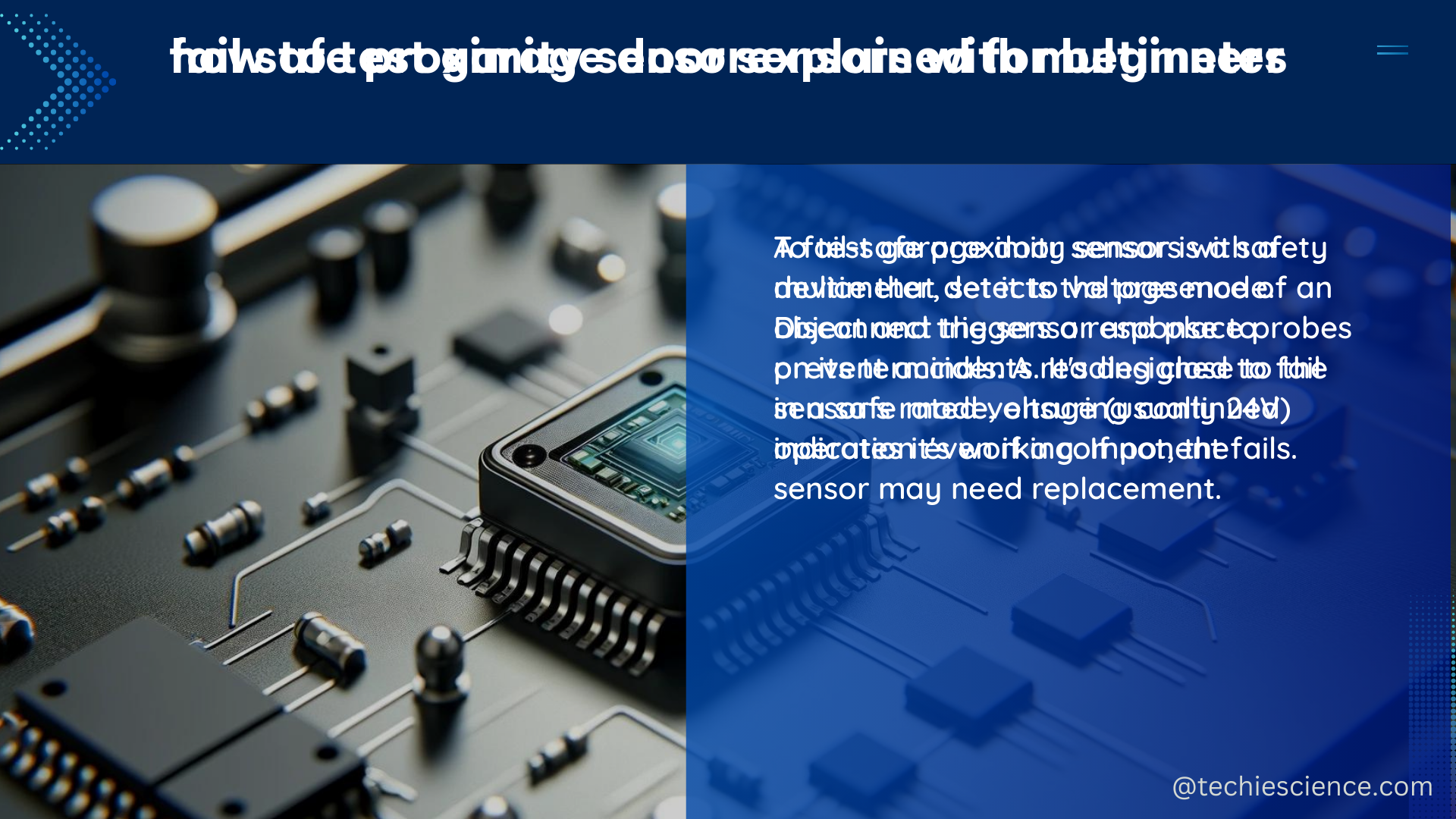A fail-safe proximity sensor is a crucial safety device that detects the presence or absence of an object within a specified range without physical contact. These sensors are designed to fail in a safe state, ensuring that in the event of a failure, the sensor will switch off, preventing any unsafe conditions.
Technical Specifications of Fail-Safe Proximity Sensors
Safe Switch-Off Distance
The safe switch-off distance is the minimum distance at which the sensor can reliably detect the absence of an object and switch off. This distance is typically measured in millimeters and depends on the specific sensor and the material of the object being detected. For example, a fail-safe inductive proximity sensor from IFM Electronic has a safe switch-off distance of 2 mm for steel targets and 4 mm for aluminum targets.
Response Time
The response time is the time it takes for the sensor to switch from the on state to the off state or vice versa. This is typically measured in milliseconds. A fast response time is crucial for applications where quick detection and reaction are required, such as in industrial automation or robotics. Some fail-safe proximity sensors can have a response time as low as 0.5 milliseconds.
Operating Temperature Range
The operating temperature range is the range of temperatures within which the sensor can operate safely. This is typically measured in degrees Celsius. Fail-safe proximity sensors are designed to withstand a wide range of temperatures, often from -25°C to +70°C or even -40°C to +85°C, depending on the specific model.
Supply Voltage Range
The supply voltage range is the range of voltages within which the sensor can operate safely. This is typically measured in volts. Most fail-safe proximity sensors are designed to work with a 24 VDC supply, but some models may have a wider range, such as 10-30 VDC.
Protection Rating (IP Rating)
The protection rating, or IP rating, is a measure of the sensor’s resistance to solid particles and liquids. This is typically measured using the IP code system, which consists of two digits. The first digit represents the level of protection against solid particles, while the second digit represents the level of protection against liquids. For example, an IP67 rating indicates that the sensor is dust-tight and can withstand temporary immersion in water up to 1 meter.
Fail-Safe Proximity Sensor Operation

A fail-safe proximity sensor uses a magnetic or optical field to detect the presence or absence of an object. When the object is within the sensor’s range, the sensor is in the “on” state. When the object is outside the sensor’s range, the sensor is in the “off” state.
In a fail-safe configuration, if the sensor fails, it will switch to the off state, ensuring that the system is in a safe state. This is crucial for applications where the presence or absence of an object is critical to the safety of the system, such as in industrial machinery, robotics, or transportation systems.
DIY Setup of a Fail-Safe Proximity Sensor
To set up a fail-safe proximity sensor, you will need the following components:
- Fail-safe proximity sensor
- Power supply
- Wiring and connectors
The sensor will typically have two wires: one for power and one for the signal. The power supply should be chosen based on the sensor’s specifications, ensuring that it provides the correct voltage and current.
To connect the sensor to the system you want to monitor, the signal wire should be connected in a way that the system will respond appropriately when the sensor is in the off state. This may involve using a relay, a programmable logic controller (PLC), or other control systems, depending on the specific application.
It’s important to follow the manufacturer’s instructions and safety guidelines when setting up a fail-safe proximity sensor to ensure proper operation and compliance with any relevant regulations or standards.
Conclusion
Fail-safe proximity sensors are essential safety devices that play a crucial role in a wide range of applications. By understanding their technical specifications and how to set them up, you can ensure that your systems are operating safely and reliably. Whether you’re working in industrial automation, robotics, or transportation, a well-designed and properly installed fail-safe proximity sensor can help prevent accidents and protect both people and equipment.
References
- Original operating instructions Fail-safe inductive sensor GI855S [PDF] https://media.automation24.com/manual/106381.pdf
- Easy Access Rules for Unmanned Aircraft Systems https://www.easa.europa.eu/en/document-library/easy-access-rules/unmanned-aircraft-systems?page=4
- Technical Explanation for Proximity Sensors [PDF] https://www.ia.omron.com/data_pdf/guide/41/proximity_tg_e_6_2.pdf
- Original operating instructions Fail-safe inductive sensor GI505S – IFM [PDF] https://www.ifm.com/mounting/80271347UK.pdf

The lambdageeks.com Core SME Team is a group of experienced subject matter experts from diverse scientific and technical fields including Physics, Chemistry, Technology,Electronics & Electrical Engineering, Automotive, Mechanical Engineering. Our team collaborates to create high-quality, well-researched articles on a wide range of science and technology topics for the lambdageeks.com website.
All Our Senior SME are having more than 7 Years of experience in the respective fields . They are either Working Industry Professionals or assocaited With different Universities. Refer Our Authors Page to get to know About our Core SMEs.